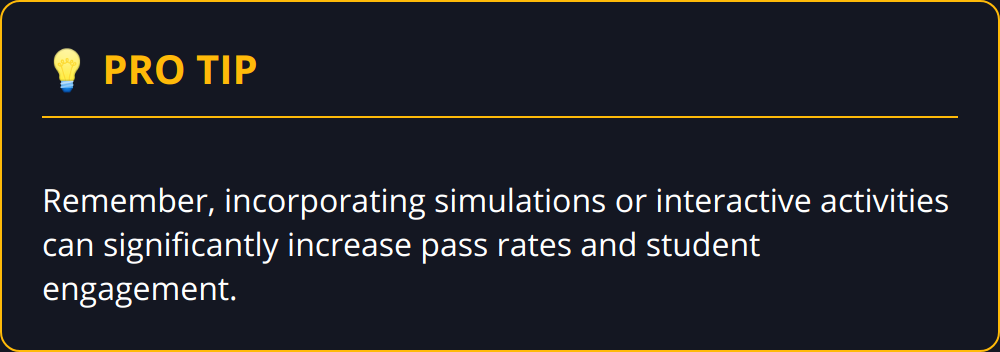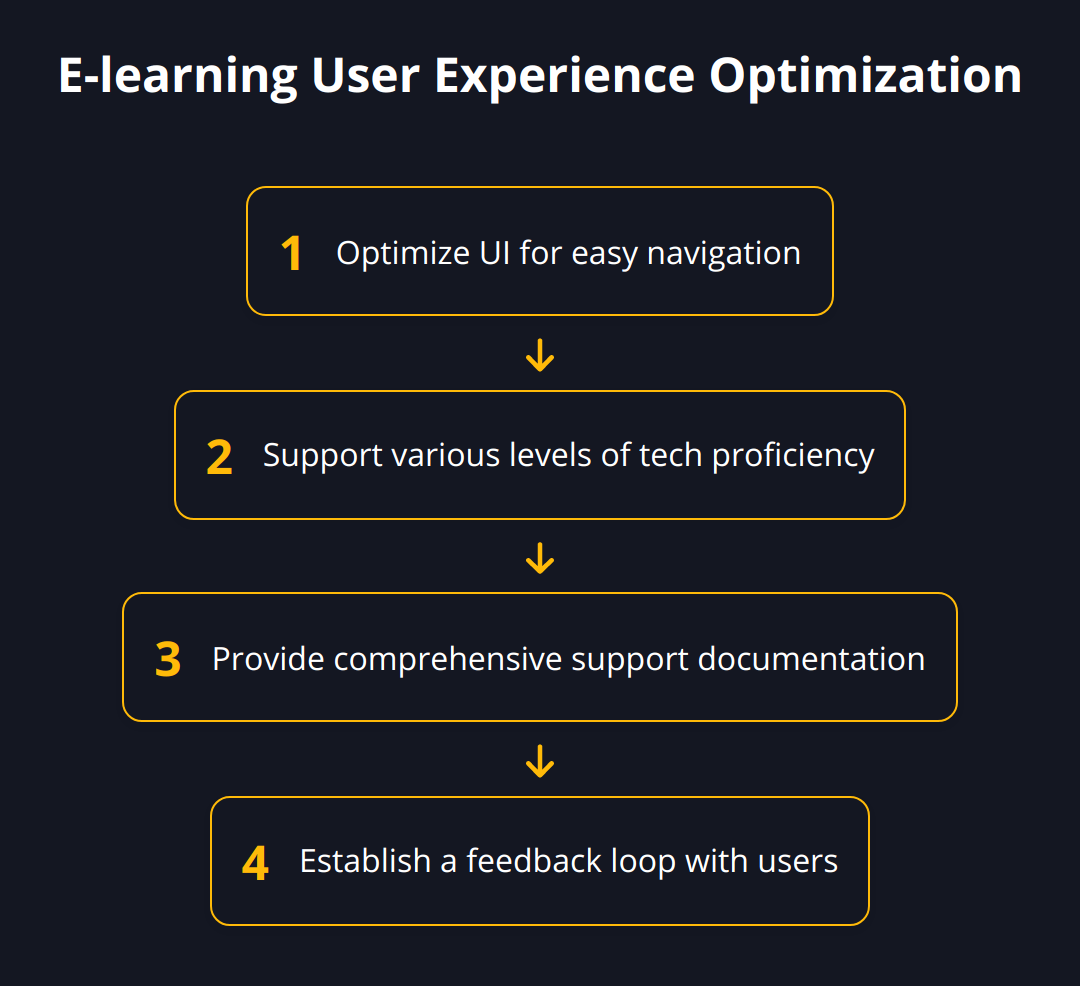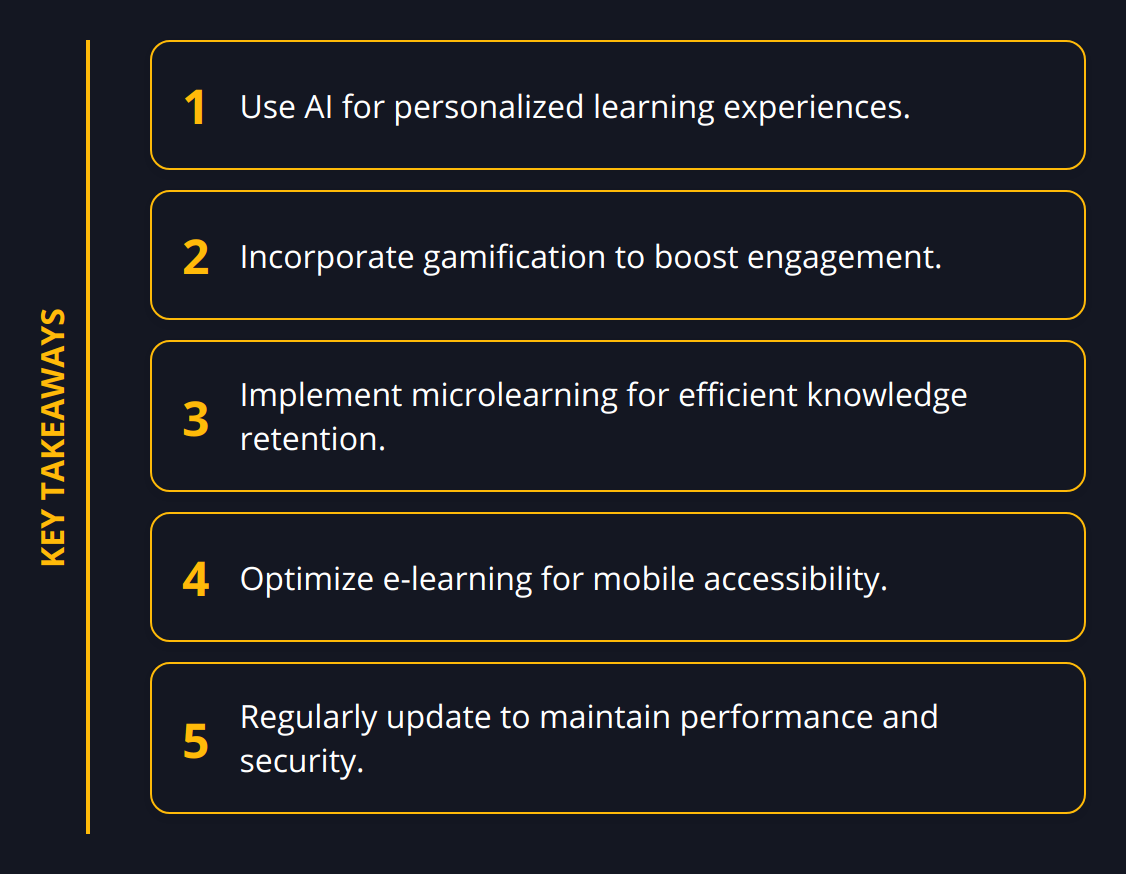At Newroom Connect, we understand that e-learning is transforming at a rapid pace. Innovations such as AI integration and gamification are not just buzzwords—they represent a significant shift in how digital learning environments operate. Recognizing the benefits of these trends, such as personalized learning and increased course completion rates, is essential for educators and learners alike. Yet, with advancements come unique challenges, like maintaining simplicity amidst complexity and upholding stringent data security standards.
Harnessing AI for Tailored Learning
Artificial Intelligence (AI) and Machine Learning (ML) are profoundly influencing e-learning, enabling platforms to offer a personalized experience that adapts to individual learning styles and paces. AI-driven analytics can pinpoint a learner’s strengths and areas for improvement, allowing for the creation of bespoke learning paths. In practice, AI can power smart tutoring systems, providing feedback and resources that address specific learner needs in real-time. A study by the National Research Council shows AI in education can improve student learning outcomes by as much as 0.4 standard deviations when compared to conventional instructional methods.

Additionally, AI’s real-time analytics give educators actionable insights into content effectiveness, leading to continuous improvement in course materials. Leveraging AI is not a futuristic dream—it’s a present-day imperative to stay ahead in the dynamic e-learning landscape.
Gaming Elements Boost Engagement
Gamification is far more than just earning points and badges—it’s a robust strategy to elevate learner engagement and retention. Incorporating game mechanics into e-learning platforms taps into the intrinsic motivation and competitive spirits of learners. A report by the eLearning Industry highlights that gamification can increase learner engagement by up to 60% and improve retention rates by up to 90%.
By transforming seemingly mundane course content into challenges and interactive scenarios, learners are more likely to stay focused and engaged. Brands are successfully utilizing gamification strategies by implementing progress bars, interactive stories, and simulation games that reflect real-world challenges. It’s clear that gamification isn’t just a fleeting trend but a strong contender in driving the success of online learning programs.

Microlearning Takes Center Stage
Microlearning is reshaping the landscape by offering concise, focused nuggets of knowledge that align with our modern short attention spans. This technique delivers content in bite-sized modules—usually just a few minutes long—making it easier for learners to digest and retain information. The efficacy of microlearning is backed by research from the Journal of Applied Psychology, stating that learning in small doses can improve knowledge transfer by 17%.
Incorporating microlearning into your e-learning strategy can enhance flexibility and encourage continuous learning outside traditional settings. Employers and educators are noticing a surge in its application for just-in-time information delivery and quick skill acquisition.
Key takeaways from the rise of these trends include:
-
AI customization is transforming passive content consumption into active, personalized learning journeys.
-
Engagement multipliers like badges and leaderboards are more than fun additions—they’re driving serious learning outcomes.
-
Short-form content synergizes with our digital lifestyles, fostering an always-learning mindset.
Moving forward, it’s evident that embracing these emerging trends is paramount for creating a compelling and effective digital learning environment. The importance of staying abreast of such developments cannot be overstated—they are not merely trends but cornerstones of a modern, tech-savvy approach to education that meets learners where they are.
How Does E-Learning Trend Awareness Benefit Students?
Keeping pace with e-learning trends directly translates into more efficient, engaging, and accessible educational experiences. Here’s how:
Personalization is redefining educational performance benchmarks. Students today don’t just want to be another face in the digital crowd; they demand a learning experience that recognizes their unique needs and adapts accordingly. By leveraging data on learner performance, educators can structure content that speaks directly to individual student needs. This personalized approach has been shown to increase student performance, with a study from the Center for Digital Education revealing that personalized learning environments can lead to higher test scores and greater student engagement.
Engaging content is the engine behind soaring course completion rates. Traditional learning methodologies often struggle to keep students interested until the end, but that’s not the case in the realm of e-learning. By crafting lively content infused with interactivity and relevance, course creators can hook students right from the start and guide them through to completion. For instance, interactive simulations can help explain complex concepts, greatly enhancing understanding and retention. According to the Interactive Learning Center, courses that incorporate simulations show a 25% higher pass rate compared to traditional methods.

Addressing diverse learning needs means breaking down accessibility barriers. Modern learning isn’t a one-size-fits-all scenario; it is a tailored suit that fits learners of all stripes, regardless of location or schedule constraints. The University of the People report states that e-learning platforms can increase educational accessibility by over 30%, primarily due to their anywhere-anytime learning model. This flexibility allows professionals to upskill without drastically altering their work schedules, or enables students in remote areas to receive the same quality education as their urban counterparts.
In harnessing current e-learning trends, students and educators alike are experiencing:
-
Improved academic performance: Tailored learning paths lead to a sharper understanding of subject matter.
-
Higher engagement and completion: Interactive content keeps learners hooked to their screens—and to their educational goals.
-
Inclusive and flexible access: Geographic or temporal limitations aren’t deterring the appetite for learning.
Looking past these benefits, it’s crucial to acknowledge the responsibility of educators to keep their digital pedagogy fresh and in line with what these trends offer. Thus, the conversation isn’t just about adopting the latest in e-learning, it’s about realizing these tools’ full potential to foster a more knowledgeable and prepared student body.

As we continue to witness a surge in the dependency on digital education tools, an undeniable fact emerges: educators and institutions need to integrate these trends not just to meet expectations, but to exceed them, setting new standards for educational excellence worldwide.
Remember, the shift towards these e-learning innovations is often backed by data and research—a solid foundation upon which educators can build and refine their strategies. For insights on crafting digital learning paths, consider referencing the guidelines in our blog post on e-learning platform key strategies.
To conclude, adapting to and adopting these e-learning trends is not just advisable; it’s imperative for creating an educational environment that is both contemporary and competitive. With a finger always on the pulse of these trends, educational systems can elevate their delivery to meet the dynamic needs of today’s varied learner base.
Balancing User Experience with Innovation
As the e-learning platform landscape diversifies, a common challenge faced by both course creators and educators is balancing the thrill of innovation with user-friendliness. E-learning systems must not only introduce cutting-edge features but also ensure that these tools are accessible and intuitive for all users. Overly complicated platforms can deter learners and impede the learning process, no matter how advanced their capabilities may be.
Firstly, e-learning platforms should focus on a clean and clear user interface (UI). The UI must prioritize ease of navigation; students should find what they seek in no more than a couple of clicks. A cluttered or confusing design can lead to frustration and decreased productivity.
Secondly, supporting varied tech proficiencies is a must. Not every learner is tech-savvy. Therefore, e-learning platforms must cater to different levels of digital literacy. This includes providing comprehensive support documentation or onboarding tutorials, such as those highlighted in our post on virtual onboarding.

Finally, regular feedback loops are essential. This means actively seeking out and acting on user feedback to continuously refine the user experience. Learners and educators can provide valuable insights on what works and what doesn’t, guiding the platform’s evolution.
Safeguarding Data Security and Privacy
In an era where data breaches are commonplace, ensuring the security and privacy of user data is not negotiable—it’s a staunch demand from users and a legal obligation. E-learning platforms must implement rigorous security protocols and regularly update them to protect against emerging threats. This includes employing robust encryption methods for data transmission and storage, as well as multi-factor authentication for user access.
Furthermore, compliance with international data protection regulations, such as GDPR, is critical. For e-learning providers, this might involve conducting regular security audits and providing transparent data usage policies. Learners need to trust that their data is safe and that their privacy is respected.
Educators must also be trained in data best practices to not inadvertently become the weak link in the chain. Our insights on protecting digital twins against security threats can be adapted to safeguard e-learning environments, as detailed in our guide on digital twin security.
Adapting to Varying Tech and Infrastructure
The final piece of the puzzle is acknowledging and adapting to the diverse technological and infrastructural settings of learners. Not all users have access to high-speed internet or the latest devices, and e-learning solutions must be optimized for low-bandwidth environments and older hardware without sacrificing quality.
One practical measure is to offer downloadable materials that can be accessed offline. This can particularly benefit learners in remote or underdeveloped regions. Moreover, responsive design ensures that the e-learning platform performs seamlessly on smartphones, tablets, and various screen sizes, making learning truly on-the-go.
E-learning platforms must also be agile in updating and scaling infrastructure to handle increasing numbers of users without a drop in performance. This might involve leveraging cloud services for greater elasticity or optimizing code for faster loading times.
By confronting these challenges head-on with pragasm and a keen understanding of the end-user’s needs, e-learning platforms can continue to thrive, making learning more personalized, engaging, and widely accessible. Addressing these considerations isn’t an option anymore; it’s a defining factor for success in the digital education domain.
AR and VR: Transforming Learning?
The educational landscape is on the brink of a significant transformation, largely propelled by advances in Augmented Reality (AR) and Virtual Reality (VR). These technologies are not only about creating buzz but are fundamentally shifting how knowledge is conveyed and experienced. The introduction of immersive learning experiences is a game-changer, offering students a new dimension of interaction with the subject matter. This leap forward promises a more profound comprehension and potentially a colossal spike in information retention rates.
In practical terms, students in medical fields, for example, can perform virtual surgeries, allowing for practice without risk. The realistic environments provided by VR simulations are also revolutionizing technical training, from automotive engineering to space exploration scenarios. It is anticipated that integration of AR and VR in e-learning platforms will continue to grow, with the market expecting an expansive 700% increase in the next five years alone.
Mobile Learning: Ubiquity in Education
Another undeniable juggernaut shaping the future of e-learning is mobile learning. With smartphone penetration continuing to surge globally, the potential for reaching learners anywhere at any time is unparalleled. The portability and convenience of mobile platforms make them indispensable tools for modern education. Expect to see more e-learning platforms prioritizing a mobile-first design approach, catering to the 83% of teenagers who prefer the flexibility of learning on their devices.
For educators and trainers, creating mobile-compatible content is no longer optional; it’s a vital cog in the wheel of e-learning strategy. To stay competitive and relevant, learning materials must be optimized for an array of mobile devices, ensuring smooth and responsive user experiences. Moreover, the growth of microlearning as a trend aligns perfectly with mobile habits—providing quick-access, bite-sized lessons that fit into the palms of learners’ hands.
Shifting Demographics and Policy Landscapes
Demographics in education are evolving, and e-learning platforms must evolve with them. As more people from different age groups and backgrounds turn to online education, e-learning must adapt to a broader range of needs and learning styles. Policy shifts also reflect these changes; in many countries, governments recognize the impact of e-learning and are developing policies to support digital education infrastructure, thus widening access and opportunities for all.
Education providers must therefore be agile, pivoting strategies to align with both demographic shifts and evolving education policies. Whether it’s supporting the needs of a diverse student population, including adult learners embarking on continual professional development, or accommodating K-12 students with varied learning abilities, the platforms of tomorrow need to be as versatile as they are robust.
Anticipating and embracing these dynamic components will be key in the ongoing development of e-learning platforms. By keeping a close eye on these exciting advancements, educators can position themselves at the forefront of the digital education revolution, ensuring they deliver outstanding value and impact to learners around the globe.
Here are a few practical tips to consider as we navigate these changes:
-
Invest in creating VR- and AR-ready content now to stay ahead as these technologies become mainstream.
-
Ensure your online courses are optimized for mobile devices, acknowledging the shift towards on-the-go learning.
-
Stay informed about the latest eLearning policies and demographic data to ensure your learning materials are relevant and accessible for your diverse audience.
It’s not just about riding the wave of e-learning trends, but rather steering towards the future by leveraging AR, VR, and mobile advancements. With intentional and strategic application, these trends will shape an e-learning reality that is immersive, mobile, and inclusive for all learners.
Final Thoughts
The e-learning platform landscape is experiencing groundbreaking shifts, influenced by the intelligent application of AI, the excitement of gamification, the efficiency of microlearning, and the transformative potential of AR and VR. These technological trends are reshaping the way we approach education and professional development. At Newroom Connect, we recognize that the key to unlocking the benefits of these advancements lies in strategic investment and an adaptable mindset.

The Pulse of E-Learning Innovation
The constant evolution of e-learning platforms is not just redefining educational methodologies; it’s creating new paradigms for knowledge acquisition. Integrating advanced technologies facilitates a learning experience that is personalized, engaging, and tailored to meet the needs of a diverse learner base. Pioneering educational tools are transitioning from optional enhancements to fundamental components for delivering impactful learning outcomes.
Investing in the Future of Learning
Investment in educational technology is paramount for institutions that aim to lead in a competitive academic landscape. By prioritizing innovation, educators can offer compelling content that resonates with learners, driving increased engagement and optimizing knowledge retention. Such investment goes beyond monetary commitment—it requires dedicating resources to upskilling educators, continuous platform development, and maintaining cutting-edge educational content.
Navigating Through Change
As the educational sector continues to navigate through technological disruptions, a willingness to embrace change is vital. It’s imperative for e-learning platforms to remain agile, responding to the ebb and flow of educational trends with swift and strategic revisions to their offerings. Adopting a forward-thinking approach ensures that learning platforms remain relevant and effective, molding the next generation of learners with the skills essential for future success.
Inclusive learning solutions like Newroom Connect further exemplify how embracing change leads to better learning outcomes. By creating virtual platforms, we cater to the evolving needs of both learners and educators. Our services are designed to make knowledge more accessible, allowing for the creation of immersive e-learning environments that mirror the innovation seen throughout the industry.
Summarily, the prevailing trends in the e-learning platform sphere outline a future where learning is:
-
Smart and adaptable, driven by AI to fit individual learning paces.
-
Engaging, using gamification to captivate learners.
-
Efficient, utilizing microlearning for knowledge acquisition in smaller increments.
-
Immersive, with AR and VR bridging the gap between theory and practice.
Newroom Connect embraces these prevalent trends to elevate the education experience. As we step towards a future where these technologies are commonplace, educators and learners can look forward to richer and more impactful educational landscapes.


